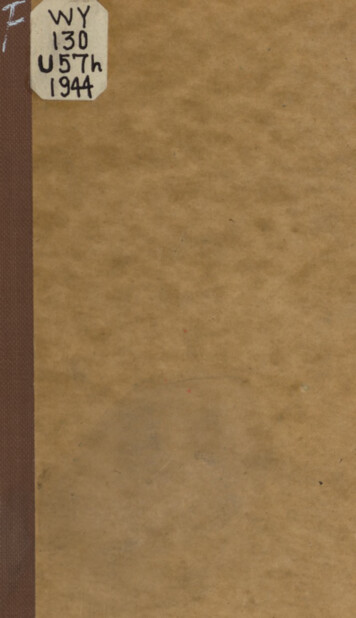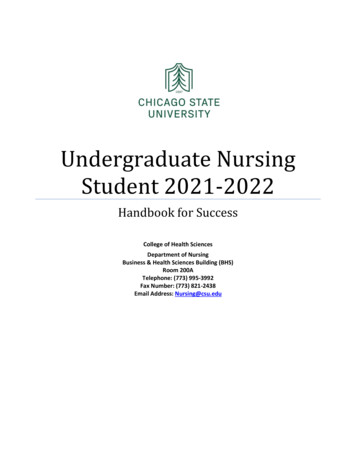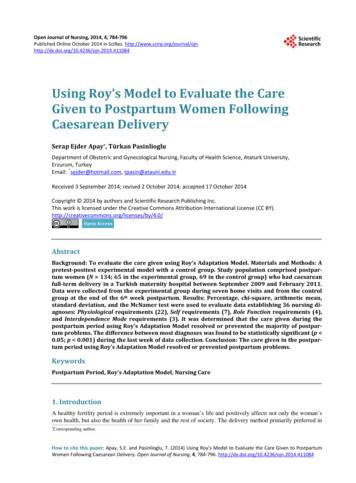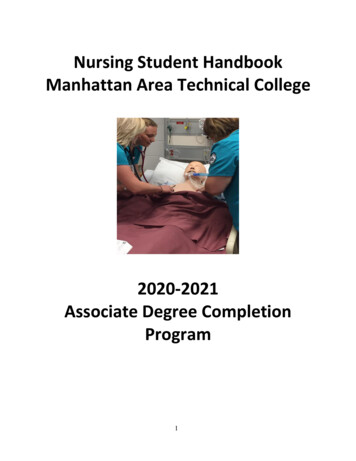
Transcription
ARMY SERVICE FORCESSCHOOL FORMEDICAL DEPARTMENT ENLISTEDTECHNICIANSFITZSIMONS GENERAL HOSPITALU. S. ARMYDENVER, COLORADOHANDBOOK OF NURSING PROCEDURESFORMEDICAL AND SURGICAL TECHNICIANS1944
INTRODUCTIONNursing is a series of basic principles that do not vary, althoughthere may be a wide range of variation of the procedures involvingthese principles. The problem confronting you as a technician is tovary these basic principles to fitthe needs of the individual patients, There is, for example, abasic method of making a hospitalbed, but this method may be variedgreatly to provide the utmost comfort for the patient. An instrument tray used for making an incision or for dressing an oper woundwould vary in content dependingupon the type of wound, but'theprinciples of sterilization wouldalways be present, achieved by themost practical method available.Always consider what measures itwill be necessary for you to use toprotect yourself in caring for eachtype of patient. Consider what measures must be taken to prevent thespread of infection to others, andalso what means of protection willbe indicated for the equipment youare using.
Examples of protection of equip-,meqt would be:1, protection of mattress by useof rubber sheet or paper.2. Choice of method and timingin the„sterilization of rubber goods.In each assignment learn whatduties you, as a technician, willbe expected to perform, whetherthese duties be to carry out theentire procedure or to preparethe equipment, assist the doctor,and care for the equipment afteruse.Learn to observe and reportabnormal conditions. Learn torecognize which are serious enough to be handled as emergencies.This book is your reference.Keep it with you while you areon duty.you will use it often.Make it your book by adding inthe space provided any specialtechniques, lists of equipment,or standing orders which mayprove valuable to you as a Medical Department Technician.
YOUR RESPONSIBILITY TO EVERY PATIENTout.doctor’s orders withexactness. If order is contraindicated, notify the doctor.A, CarryExamples:1. Respirations below fourteenper minute if morphine isordered,2. Oral medications if patientis* vomiting*B. Use nursing measures to relievediscomforts; keep bed dry andfree from wrinkles, observerults of oral hygiene, etc.C. Observe and report signs andsymptoms,D. Prevent the spread of infection:1, Use only clean thermometers 2. Give adequate care to contaminated dishes.3* Dispose of germ laden’dressings properly.A, Keep your hands meticulously clean.E, Prevent complications. Examples:1. Avoid secondary infection inburns 2, Maintain correct positions inburns and orthopedics.F, General observations:1. Is patient getting enough rest?2. Is the food adequate for hisneeds?
II* OUTLINE FOR NURSING PROCEDURESAo Define procedure. Plan your action.is the prupose of thisWhatB.procedure you are to do? What 1results should be expected?Is it clean or sterile?G. What equipment do you need?To save time and effort, prepare lists of equipment necessary for common procedures*TestD.your equipment. Faultyequipment may cost a life. Examples:.1* Equipment to be used assterile not sterilized.2. Hollow instruments (cath-eters, needles, etc)plugged or dirty on innersurface*3* Glass syringes misnatedor stuck.E* What will you record?F. Avoid spread of contaminationby careless handling of usedequipment. Care of equipmentis not complete until it isclean or sterile and returned,to its proper place ready foruse again.,
III.RULESFOR CLEANINGEQUIPMENTA. If used in isolation or on septic wound, disinfect beforecleaning.B. If bloody, wash with cold water.G. Wash well with soap and water.3e sure that hollow equipment(hollow needles, catheters, enema tips, etc.) is clean insideas well as outside. tD. Rinse well in clean water.E. Boil the following items for 3full minutes:Levine tubesEnema tipsRehfuss tubes Oxygen masksStomach tubes Oxygen cathetersColon tubesF. Put away and cover clean equipment until it is ready for use.G. Boil the following items 13 to20 minutes;DishesMedicine glassesDrinking glasses EnamelwareDrinking tubesH. Bed pans and urinals are sometimes cleaned and sterilized byspecial flush and steam equipment. They may also be cleanedby washing well with strong soap,or 3/o solution of Army Germicide#3.
IfDininfeotion1.of thermometers*Place thermometer in greensoap'2. .uipesolution.Tjltiigauze or tissue,aspiral motion. Beusing’3.1'sure to start' at end oppnsite mercury bulb.Place'thermometer in anydisinfecting solution available. The strength andtiming 17111 vary with thesolution used, Read labelon bottle thoroughly.Neutralize with alcohol toprevent burns from 'disinfect ant, If possible, letthermometer' stand' in al*»cohol one full minute.4.
IV.PREFERRED RET.‘.CDS OF STERILIZATIONA. Articles to be sterilized" byautoclaving:1. Ordinary instruments.2. Sharps, if so ordered. (Protect edgbs of sharps withcotton).3. Syringes. (Separate pistonfrom barrel).A. Needles, both hollow andsuture 5. Rubber goods, includingrubber gloves.6. Suture material."7. Solutions. (Fill jar only2/3 full. Do not use vacuum.Refer to autoclave instructions fortiming)*0. Ointments. (Place in pans tocatch overflow and seepage) 9. Vaseline gauze, if hot airmethod is impractical.10. Enamel ware.11. Linen.12. Glove powder, in snail’quantities.articlesto be sterilized by ;Ailautoclave should be nut up in containers in which they can be sterilized, stored and removed withoutcontamination.
B.Articles to be sterilized byboiling:1. Ordinary.instruments 3 BO-BOmin,Syringes,2.13-20 min. Sep-arate the pistons fromthe barrels,3.Needles, 5-10 min. Insertstylets before boiling.unlessmarked non-boilable, 20Suture materialp0 mini.Soft rubber goods to beused as sterile l -20min.6, Water to be used as sterile ’should be boiled for20 min.Articles to be'sterilized by5.G,}chemicals;1, Sliarp instruments,forin Phenolplacetwo min-utes. Rinse in sterilewater and place in alcohol*D,70f- for10 minutes,needles "or syringes, Rinsewell with sterile water before use,Articles to be sterilized, bydry heat:1* Needles and syringes,2,Ointmentsvaseline gauze,3m Powder, when sterilized inlarge quantit ies,2#
V,PROCEDinSS* TO "ESS DO!IEiETTIICDSA! I EQUIPMENTBedmakingThroat irrigationsNasal irrigations'GavageTemperaturesStupes (if skin is unbroken)BathsEnemasLavageEquipment to be used as clean:Ice bagsErnes is basinsHot water bottlesAir cushionsMedicine glasses Drinking glasses’Bed pansDrinking tubesUrinalsKitchen utensilsOxygen equipment ' s t of clean equpment;Mould YOU be willing to have thisequipment used on YOURSELF?is
VI. PROCEDURES TO BE DONE WITHSTERILE EQUIPMENT;Puncture procedures;Hypodermic injectionsVeni punctureHypodermoclysisChest tapSpinal tapAbdominal tap (Paracentesis)Incision and drainageDressings on open woundsCatheterizationBladder irrigationsWhile setting up a sterile trayor assisting a doctor with asterile procedure, it is best tomask, use sterile ’'pick-up 1' forceps, and always avoid reachingover the sterile field*
VII. BATHSA.4Cleansing baths: bed bath, tubor shower, choice dependingupon the patient*s strength andfacilities.1. Assemble all equipment,Avoid drafts, make temperature of room comfortable,3* Test water temperature,4, Expose only the part of thepatient being bathed; avoidgetting the bed wet,5, Handle patient gently, aidhim when turning*6, Change linen after bath.Therapeutic baths; (given onlywith Doc tor s order),1, Tepid or cold bath: givento reduce temperature* procedure the same as for cleaising bath, omitting the soajbut the water is tepid orcold. Apply the water withyour hand or a cloth, thenpat dry, do not rub dry,with towel. Place an ice .bag or cold compress at thepatient*s head and a hot'water bottle at his feet.It may be necessary to protect the bed2.B,*
with a rubber sheet. Recordthe treatment, temperature'atend of treatment, and the temperature one hour later.Alcoholsponge bath, given to2.reduce temperature. Alcohol isapplied with the hand in generous amounts with some massage. Record the treatment,temperature at end of treatment, and the temperature onehour later.Sitzbath, used to relieve3.1congestion in the pelvic region. Often ordered following?andproctoscopicrectal operations. Watershould ,be as hot as the patientwill tolerate, and the bathshould last from ten' minutesto one-half hour, dependingupon the patient's strength.4. Sedative pack, used to inducesleep or relax as mental patient is wrapped in blanketsand wet sheets (avoid wrinkles) until the desired dergree of relaxation has beenaccomplished.
VIII.NURSING CARE OF BURESA. Equipment assembly for emergency treatment*Sterile hypodermic set-up fortetanus toxoid, gas bacillusand morphine.Plasma and venoclysis set.Vaseline and RO mesh gauze,sterile.Sterile gowns masks for everyone.Equipment for shock bed.B. Refer to S.G.O* Circular Letters concerning Burn Treatmentsfor both emergency and definitive treatment*C. Observe and report signs andsymptoms indicative of nDelirium or stuporNauseaVomiting Symptoms of localExtremeinfection.,thirst.D* Follow doctor’s orders accurately.Contaminateddressings should beE.wrapped for burning* Contaminatedequipment should be immediatelydecontaminated after it has beenin contact with an infected patient.;r"
IX. NURSING CARE OF COMMUNICABLEDISEASEA. Respiratory diseases, spreadthru oral and nasal dischargesDiphtheriaTuberculosisCommon ColdMeaslesScarlet FeverPoliomyelitisInfluenzaMeningitisSeptic SoreMumpsPneumonia 1throatB. Intestinal diseases, spreadmainly thru alimentary discharges:TyphoidParatyphoidBacillary DysenteryAmebic DysenteryCholeraC. Insect-borneMalariaYellow feverDengueTyphus diseases;Trench FeverBubonic PlagueFilariasisTularemia
D* Isolation, This is a techniqueemployed to prevent the spreadof a communicable disease fromthe patient to others* Infective organisms are carried bythe hands and clothing of persons who come in contact withthe patient or his surroundings, on dishes, linen, nursing utensils, and personalarticles that are contaminated.Personnel attending the patientshould be gowned, and the following rules observed:1. Gown should cover entireuniform.2m Neckties and neck band shouldbe kept cleanGown should be nut on andtaken off in such a ;ay thatthe inside remains clean.4. Gown, if hung outside cubicle,must be hung with contaminated side folded in.5. Personnel should be masked,flasks should be of closely3.woven material, clean, dry,and should cover nose andmouth. Masks are worn toprotect yOU, as well as thepatient*
Some general rules of isolation 'to be remembered are:1. Bed linen, towels, pajamas,attendant’s gowns, etc., areplaced in a bag narked isolation before being sent tolaundry. There they are autoclaved or disinfected beforebeing handled.2. Dishes and enamel ware areboiled, autoclaved or soakedin 3 % Army Germicide #5«tissues and foodDisposable,3*scraps will be wrapped in;aclean wrapper and disposed ofby burning.With intestinal diseases andpoliomyelitis, the fecal discharges and urine must be disinfected before it is-disposedof. This is done by.soakingthese discharged in 3% ArmyGermicide #5, or any othergermicides available.3. Keeping the patient in bedwall help prevent complications, and help prevent thespread of infection.
Rules of Terminal Disinfection:1. Patient should be bathed anddressed in clean clothing.2. Personal articles that cannot 4be disinfected should beburned.3. Hattresses can be autoclavedor aired in the sun for 6 hours on each side.h. Furniture of the patient’sunit should be washed withsoap and water and aired thoroughly5. balls woodwork and floor shoulcbe meticulously scrubbed*.}
:{fI#3,3,f.f,NURSING- CARE OF PHEUKONIAFollow the general rules ofisolation when caring for apneumonia patient.Comfort is important in thetreatment;of pneumonia* thisincludes good general nursingcare, frequent and completeOrel hygiene, alcohol rubs,change of position, warmth andfreedom from drafts,Mental rest and freedom fromworry are important factors inrecovery. Visitors should berestricted or limited, visiting tine should be brief,Absolute bed rest is essential.The patient should be assistedto turn in bed, he should be'fed rather than feed himself,and he should never be awakenedexcept for the administrationof suTfa drugs,Record intake and output daily,Note and record any abnormalsigns or symptoms, cyanosis,intolerance for sulfa drugs,recurrence of fever, etc.
XI* PREOPERATIVE CAREA* Mental preparation:Your patient should be reassured that he will be all rightafter the operation, for fearis a major factor in the failure of some operations*B. physical preparation:1# Rest, usually with sedation.2. Diet, usually restricted-tofluids immediately prior tothe operation.3. Skin preparation; area aboutthe site of incision shouldbe shaved the evening beforethe operation; scrub of areawith green soap and alcoholafter shaving is optionalwith the surgeon. Skin preparation will be completedin the operating room.Immediatepreoperative care;4*Have patient empty bladder.Remove jewelry and falseteeth. Give preoperativemedication.
XII. POSTOPERATIVE GAPEA,‘1.Prepare postoperative bed .before the patient returns to theward.1, Extra blanket should beright over patient.2. Bed should be pre-warned.Protect bed with rubber sheetClearspace so litter can4»be wheeled in 'without delay,Immediate care;1. handle patient gently,2.Observepulse, respiration,Skin, lips, nails for sighsof shock.3., Check dressings for hemor:*' rhage 4, ’Stay with patient while he5* G.6;is unconscious,Be prepared to start I,V.fluids Have erne sis basin, mouthwipes, scratch pad, andpencil on the bedside table,General Care;1, Change linen and pajamas asoften as necessary,2, Record accurately intakeand output.
3. Encourage patient to empty4.5.6.7.8.bladder 8-12 hours after- theoperation. Be prepared tocatheterize if patient cannot void voluntarily*Enemas as ordered,Strict oral hygiene 1 at leasttwice a day,Watch diet closely, from, surgical liquid, liquid, light toregular,Prevent respiratory infections,Encourage deep breathing, chanposition frequently, and encourage pabient to cough,Give patient whatever assistance he needs, with personalhygiene, meals, etc. If he isunable to see, arrange his'foo*in a logical manner (as in relation to the figures on aclock) and tell him where eachkinci of food is on his plate.
XIII.NURSING CARE OF PATIENTIN CASTnot cover cast while it iswet, but a Hot; it to dry thor-A, DoB,oughly,Watch for evidence of pressureas the cast driesj cyanosis,pain, numbness or swelling mayresult from a tight cast.C, Watch for skin irritation atthe edges of casts,D, Make the bed in such a mannerthat the weight of the coverswill not be supported by theaffected part. Additional covers may be necessary to protect the chest or lower limbs.Avoid drafts by tucking thecovers in at the bottom of the bed.Protect the cast when the patient uses the bed pan if it isa low body cast or a high legcast.o'. If the cast is a heavy one,assist the patient to turn inthe bed whenever possible. Fora double spica of the hip, always have two technicians toturn the patient.
HVA,B,C.D.Li Id To,Cleanliness is the primary ruleto be remembered in any kitchen.Tray should be attractive as itcan bo made. Avoid spillingsoup or beverage*Be sure that patient can reachfood. Assist him whenever youcan.Common diets are;1. Surgical liquid: Broth, tea.fruit juices and carbonated2.3.beverages*Full liquid; As above, withthe addition of milk, creamsoup,’ jello, and ice cream,Soft;bakedPoached eggs, toast,potatoes,cookedstewedfruitcereal,Dental soft; includes theabove" with'" ground meat andvegetables.Light; Gait heavy moat,(pork, highly seasoned meat*fried foods, and pastry,Regular; includes all average"" foods*4.5.*
IV.STANDARD NURSING PROCEDURES1. Irrigations, general:Equipment used for irrigationsmay include;Irrigating can with tubing andtip,- bulb syringe, piston syringe, or medicine dropper.Choice will depend upon equipment available and cavity, tq beirrigated.Solution for irrigating.Treatment sheet to protectclothing and bed.Receptacle for waste.tClean or sterile sponges forcleaning area around cavity.2. Eye irrigations:Sterile procedure if possible.Solution commonly used:Boric acid Sterile waterSalineSoda water 'Position of patient:Sitting or lying in a position which will allow thesolution to escape at theouter cantbus of the eye.Direct flow away from nose intothe pocket made by retractingthe lower lid.- ,
Dangers to be.avoided;Injury to eye with irrigatingtip.Us of wrong solution.Infection from unsterile equipment,3. Ear irrigations:Sterile procedure only if infection ispresent,or if skin orismembranebroken.Solutions commonly used; .Sterile water Normal salineBoric acidPosition of patient:Sitting or lying in any position that favors a return flow.Dangers to be avoided:freessive force Failure to provide for returnflow.L* Nasal irrigations;C1ean pr oc edure Solution co mionly used:Normal salineTap waterPosition of patient:Sitting vdth head bent forward,or with head turned to side andsupported with billows.'
5 Throat irrigations:C1ean procedure,Solnt ion s coiandhly used;Normal saline Tap waterPosition of patient;Sitting, with head bent forward to favor return flow.Avoid aspiration of the irrigating fluid by the patient,after ach irrigations;Time of treat .cnt.Solution used.Nature of return flow.P,ecordClean all equipment and returnit to storage place ready forthe next person to use,6 Ext ornal applic at ions:Net Drossings:Sterile if there is a break inthe skinaboutthe area of the dressing, With all equipment sterile, thedressing nay be put on the skindry and the solution added withan asepto syringe, or the dressings may be put in pan of solution and applied with
ipiGhsiipM forceps Clean wet dressings may be wrung out by hand.Always protect the patient'sclothes and bedding from becomingmoist.If the skin becomes irritated, itnay be protected* b3r applying oilor ointment about the area.Hot applications should be madethick enough to retain the heat,unless there is danger from pressure. If this danger exists,- frequent' change will be necessary.(This is usually true of eye applications) Cold compresses willbe made thin.*.Hot water bottles:Fill bottles only 2/3 full, andconsider the weight of the bottlewhen applying it to the patient.Do not have it hot enough to burnthe ‘patient, test it yourself first.Always use a bottle cover or blanket for protection# Never amplydirectly to patient's skin. Watchclosely for burns on unconsciouspatient.Test for leaks and expel all airbefore applying#Use onlv clean water#
Ice capsAvoid using sharp pieces of ice.Avoid using crushed ice. It istoo heavy and melts too fast,hatch for symptoms of frostbite;cyanosis, swelling and circulatory*failure.Use only cleanice.Test for leaks.Use coyer or towel to protectpatient,7* Intravenous infusions:Equipment Sterile flask with solution,Sterile tubing with clamp andadaptor.Sterile need’’ ;s.Tourniquet,Treatment sir ct and towel.Antiseptic solution for preparing skin, with necessary sponges.Forceps in solution.Receptacle for waste.Adhesive to immobilize needle.Duties of technician:Preparation of equipment Assist'doctor 1 in starting procedure, or completing entireprocedure. Watch patient thruout procedure. Record tine,amount and kind of
solution, .and nameprocedure.of per:-,I- g.Dangers.to. be,avoided; .V/rong ,s olut ionInfection from unsterile equipment.Running solution too fast.Billing.needle out of vein, or pushing needle.through vein, B, Enemas:Equipment (clean),Irrigating can or funnel.Tubing with clamp.Enema.tip or colon tube.Treatment sheet and cover.Lubricant,Standard,Bed pan with, cover*Toilet paper.Solutions frequently used*Saline’ (one tsp. salt*to 500 cc.’s'of water),Soda (One tsp, to 500 cc.’s water),i apr .a u cr Soapsuds. (Use mild soap),.Amount of solution for cleansingenema is usually 500 cc, of solution.
Position ox patr it for enema;Preferable pos:’ ion is on leftside with as few pillows as possible for support* If patient isunable to retain enema, allow.him to remain on back with bedpan under hips* To expel enema,patient will be elevated on pillows* Ambulatory patient may usebathroom*Record:Time of treatment*Solution used, results obtained*Abnormalities of return fluid*Care of equipment after use:Wash well with soap and water*Glean tubes inside as.well asoutside.Enema tip or .tube should beboiled for three full, minutesafter use. lie turn equipment clean and ready-for use again.Allow patient to wash well afterthis procedure.Be sure bed is clean and dry before leaving patient*r
9, Catheterization: (Sterile procedure) Equipment; (Sterile)Rubber catheters - 2 LubricantMedicine glasses, 2 Sponges2 ForcepsSolution bowls,SyringeSpecimen containerAdditional equipment;Antiseptic solution lor.prepar,ingfield.Antiseptic solution for instillation-if ordered.Sterile gloves in wrapperReceptacle for urineReceptacle for wasteTreatment sheet and coverRecord;Time of treatmentAmount of fluid obtainedName of person doing procedure
10. Aspirations:cedure’s)’’.’(Sterile pro-Sqivipnent:Syringe, with novocains.Springe, for asmiration.Needles, assorted sizes. Spinal needl.es if for spinal tap.Antiseptic f ,.r skin preparation.Medicine glasses.Applicators and sponges.Forceps.Specimen tubes.Sterile gown and drapes.Sterile gloves.Graduate measure.Treatment sheet.Receptacle for waste.Technicians’ duties:Preparation of equipment.Assist during procedure.Record time, amount and character of fluid obtained, nameof person doing procedure.Take specimen to laboratory.Care for equipment.**
il* Hypodermic nedicatlons;Equipment;Sterile syringe*Sterileneedle.Sterile prepared solution, ordrug tablets to be dissolved insterile, water. (Spoon method)Alcohol sponge.,Procedure; „Assemble syringe and preparemedication. (If you are not supplied with the drug In the dosage ordered, divide what youwant to give by what you have onhand. If your order is for pantopon gr. 1/A and you have gr. 1/3tablets; Divide l/A / 1/31A x3/1 3/A. Therefore you will use3/A of the. tablet in. the numberof minims divisible by four. Use16 minims to dissolve the tablet,and give the' patient 12, discarding the other four minims containing l/h of the tablet).Choose site of injection.Prepare site of injection withalcohol snonge.Expel all air from syringe. -
Inject solution with needle heldat angle of about 60 degrees.Withdraw needle and massage areagently for a few seconds.Record on patient’s chart.Record on narcotic record.Observe and note reaction todrug,CAUTION; Always he sure that youare administerin the right drugin the correct a :ount to theright patient. If morphine is being given, count the respirationsbefore administration. If respirations are'below 16 per minute,withhold drug and notify doctorimmediately 12. Pouring medications:Be sure of'time and dosage.Read label three times.Never risk unlabeled bottles.Never talk while pouring.Snake well if in suspension.Hold measure level with-eyes.Pour from side opposite label.Dilute liquids, except cough mixture,Record,Know and watch for normalKeepmedicines locked.results.
13*Preparation of DressingCarriageSterile SuppliesInstrumentsDressing.ForcepsTissue ForcepsHenostatsTissue scissorsSuture ScissorsScalpel Blades .Knife HandlesOintments:Petrolatum JellyBoric Acid Dint*Zinc Oxide Oint.:Dressings:ABD Pads( x 8 f 64 x 4's2 x 2fsTonsil SpongesApplicatorsSolutions:Boric AcidNormal SalineSterile WaterH3rd.r0 genPeroxideDrugs:Gential violetIodine,3%Ether or benaineSilver NitrateAlcohol,t? DUr fJ95% Unsterile Suppli.es:Emesis BasinsRoller BandageSafety pinsReceptacle for WastePaper for Soiled Dressings, Etc.
14* Preparation of dressing tray:-(Used for changing dressing.ononly one patient).The sterile supplies, instruments, dressings, drugs, andsolutions, and the unsterilesupplies used on a dressingtray will vary with the type of dressing to be done, andwith the standing orders fordressing the patient. It isused for convenience in dressing a single patient.
15.* Oxygen TherapyEquipment:.Oxygen tank.Oxygen mask’, nasal* catheter orOxygen tent.Lubricant for catheter.Adhesive for immobilizing catheter.Humidifier.-When setting up equipment foroxygen therapy, always takethe following precautions:"Crack the valve" of the tankto avoid injuring valve mechanism. Avoid use of oils onequipment. Never -allow smoking in room. Follow directionswith equipment Do not waste oxygen.
XVI.AVERAGE DOSAGE-OF DRUGS'MorphinesulfateIiETRIC . APOTHECARY0,000 Gin. gr, l/B0,01 Gm. gr. 1/6(narcotic) 0,016 'Gu,gr.1/40,016 Gm.gr,gr,l/4l/2Codeinesulfate0,032 Gm.(narcotic)0,064.vy Atropinesulfate''Gm,'gr, 1,00043 Cm. gr,.00065 Gm. arcotic),0025 Gm.(narcotic),02Scopolamine,00043 Gm, gr,JOOO63 Gm, gr,1/150l/lOOl/32'1/241/6l/31/150l/lOOStrychnine ,001 Gm, gr, 1/60sulfate,0005 Gm. gr, l/lOO(Equivalents are approximate)
XVII. EQUIVALENTSGrams or cc, f .41530500Grain er Minims151/101/1001/21/41/3APPROXIMATE EQUIVALENTS1 teaspooncc.—1 dram1 tablespoondrams—cc.—4.—cc.—1 ounce— 2 tablespoons2 tumblersfulcc.—1 pint1000 cc,—1 quart— 1 liter—
XIX.00:1,IABBREVIATIONSsof eachas much as desired*galloncentigradewithcubic centimeterwhile the pain lastsLet it be madegram, gramsgrain, grainsa drop, dropsaaad,lib*C,C,cc.c,Dur, dolorFt,Gm,'gr. 'gtt*L, ‘min,'' 'N.b*0* ’'a 1 Iterminimnote troll a”'- pintQ*s,as much as is sufficientRx*takewithoutif sS,o*s*Ss,Tp,Tbsp,Dr,Os,’
A r c,Alt. die.Alt. Bor.Alt, noct.Before' mealsalt 0 .at e y;: 2alternate hoursB*i.d.alternate nightstwice in dayH,hourII.s.p.c.p.r.n.Q,h.Q,2.h.at sleeping tineafter r.ealsQ.i.d,when requiredevery hourevery two hoursevery four hoursfour tines a dayStat,at onceT.i.d,three tines a dayQ.h.h.t.i.d.P.C.8 Ah, 12N, 4 HI,8 HI.B Ah, 2 ?h, 6 PII
The following blank pages are tobe used for star ing orders, specific procedures an. , any additional1,information that nay be valuablefor you*
43
45
INDEX,Page Par. Sect,Abbr eviati ons, 4-0 XIXcommon11 VIIBurns, nursing care 13 VIIICasts, special care 22 XIIIBaths5 IIICleaning equipmentCommunicable diseasenursing14 IXDiets23 XIVDosage of Drugs Equivalents38 XVI39 XVIIEquivalents, approx,39 XVIIIPneumonia,nur s ingcarePostoperative carePreoperative careProcedures, cleanProcedures, general18 X20 XII19 XI9 V4 IIoutlineProcedures, standard 24 XVApplications;Hot water bottlesIce capsWet dressings26 XVAspirations:32 XVCatheterization31 XVDressing carriage 35 XVDressing tray36 XV4761091314
Ear irrigations.Enemata Eye irrigationHypodermic MedicationIntravenous InfusionsMedicationsNasal irrigationOxygen therapyThroat irrigationProcedures, sterileResponsibility to PatientSterilization25 XV 329 XV 824 XV 233 XV 1128 XV 734 XV 1225 XV 437 XV 1526 XV 510 VI3 I7 IV
INTRODUCTION Nursing is a series of basic prin- ciples that do not vary, although theremay be a wide range of varia- tionof the procedures involving these principles. The problem con-fronting you as a technician is to vary these basic principles to fit the needs of the individual pa- tients, There is, for example, a basic method of











